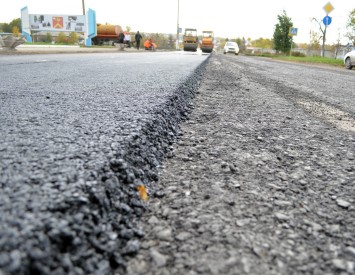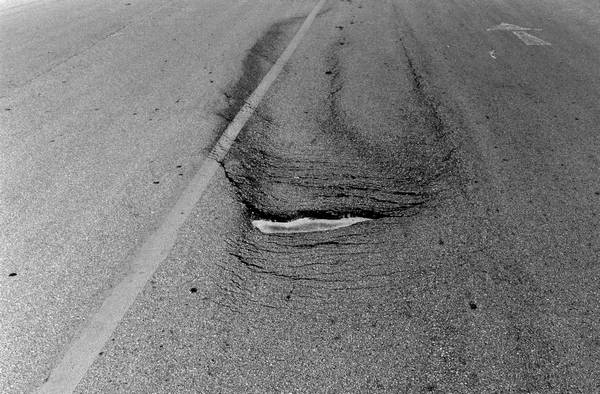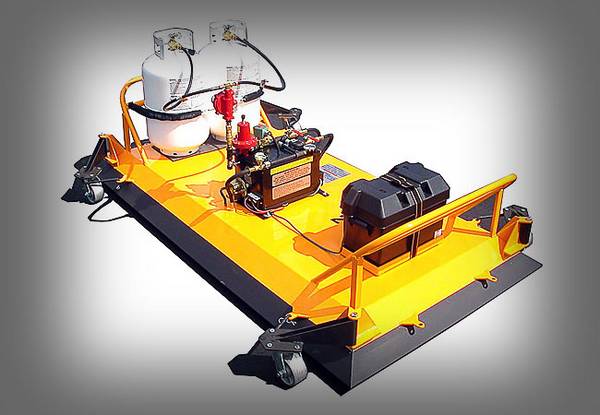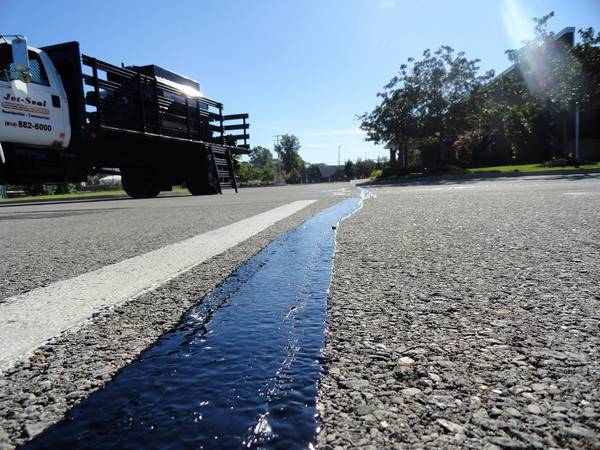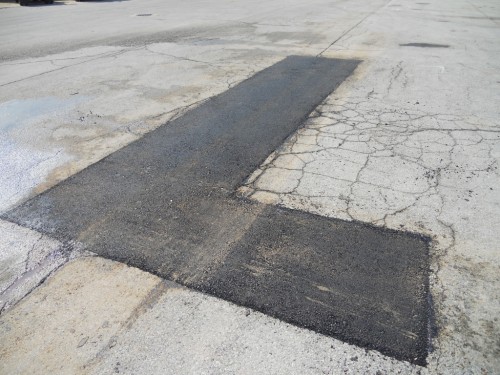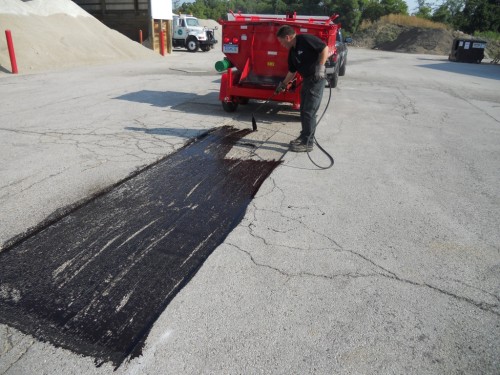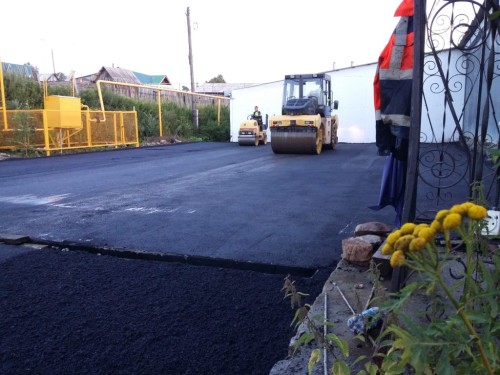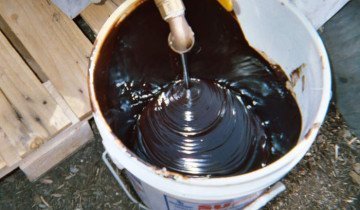In detail: do-it-yourself asphalt pavement repair from a real master for the site my.housecope.com.
In this article, we will consider how to repair asphalt in the local area. Let's find out what cracks are in general, the main reasons for their appearance, what to do to extend the durability of the asphalt pavement. Consider the existing technologies for repairing it, and especially those methods that can be applied directly to the local area.
- The causes of cracks
- What are the cracks?
- Asphalt repair technologies
- Features of the repair of asphalt in the local area
Firstly, it is the weather conditions. Water that somehow gets into the roadway destroys it. An equally serious enemy is salt, which many owners love to use as a remedy for ice in the winter. With all this, people miss the fact that the asphalt is already under another annoying factor - the ice crust.
Still, you can't argue with the weather, but you can try with the human factor. Most of the cracks are due to the unprofessionalism of the workers. Let's take a closer look at them. 1. Excessive shrinkage: - large regular loads (this is rare on a private site, unless construction is underway and a car with heavy concrete blocks and other building materials is not driving around the territory); - seasonal deformation at high temperatures (when the sun bakes, do not force the asphalt to "hold" a large load). 2. Failure to comply with the laying technology. See who you hire, so that later, after the would-be workers, you do not have to repair the asphalt with your own hands. 3. Ignorance of the individual characteristics of the site. Often, the owners are not at all interested in the level of groundwater, the depth of freezing and other features of the soil. Yes, it is not necessary for everyone to know, but it is advisable to remember their importance. There are companies that faithfully lay asphalt and measure everything themselves. There are also ordinary teams that don't care how long the coating will last you, they just do the job. They do not pursue quality, but they also do not rip to the skin.

Video (click to play). There are many of them, walk along the usual central road of a provincial town and you will be convinced of this. Transverse and longitudinal, like a spider web and with a shift - they all somehow arose. And all of them must be "treated".
Longitudinal cracks do not arise from regular loads on the site. They are a consequence of the seasonal whims of nature - the alternating drainage and moisture of the soil. An overabundance of air voids, a high temperature of the mixture production at the enterprise is the cause of the emergence of group cracks. They intersect at different angles. They are frequent guests on personal plots, because there are no regular loads that would give elasticity to the coating.
Cracks resembling cobwebs are called "crocodiles".
They are also called fatigue. Asphalt ages, oxidizes and is simply not able to serve as a reliable coating, so it is advised not to repair it, but to replace it. It is also suggested to do it with shear cracks. They arise due to the rupture of the connectivity of the layers.
Of course, it is not so important to close up cracks in the local area, as, for example, on some highway that allows hundreds of thousands of trucks per day. However, the appearance of the property is the face of each owner. What is the difference between a crack in the asphalt in the yard and a cracked tile in a bathroom? That's right, nothing, everything needs repair.
The technology of patching of asphalt by points: - first, they are determined with the boundaries of the repair, outline the perimeter; - cut out the damaged asphalt pavement; - remove the remnants of the material; - an asphalt concrete mixture is laid (this is a compound of crushed stone, sand, refractory bitumen and mineral powders, which is available in stores); - level and compact the coating.
The technology of infrared repair of asphalt deserves special attention. This innovative solution leaves behind the traditional methods of restoring this coating. No noise when removing damaged asphalt, work is carried out without restricting traffic - just some of the advantages of the method.
The use of infrared radiation (by the way, invisible to the human eye) allows you to heat the roadway from the inside without affecting the upper layers. In addition, it is a more economical method when comparing energy costs. Additional milling devices are not required during the repair. Loosening of the heated asphalt is carried out with improvised tools. As a result, we get the absence of seams and fewer operations to eliminate the defect. And less asphalt concrete is added.
In most cases, there is not so much asphalt on the site to pay a lot of money for the use of innovative technologies. A jack of all trades will always find a way to get rid of coating defects cheap and cheerful.
Why dismantle an entire section if it's easier to just cover up the crack. Especially if there are several such troubles or just one. Experienced people advise using bitumen to fill cracks. The store is full of hot and cold sealants to fix this problem. The choice is yours, as not everyone dares to work with high temperatures. For many, the price of asphalt repair is also important. In any case, doing it yourself is several times cheaper. Sealants will protect the coating from the main enemy in the local area - water.
The sequence of repairing cracks with bitumen is as follows:
1. First, sweep the area to be repaired.
2. Blow out the area of rupture of the coating, thereby removing the remains of debris and dust from it. At the same time, the fracture is drying out, because precipitation or high humidity is likely there. In addition to all this, it is not advised to make repairs if weather forecasters promise rain or snow.
3. Then the crack cavity is heated. For this, a heat spear is used. The surface should be heated until the bitumen begins to thaw. It is important not to overdo it here, because burning it will entail the destruction of the adjacent coating.
Another option is to use bitumen rubber tape. It is used both for sealing joints in the initial stages of asphalt laying and for filling cracks. Let's take a closer look at this option as well.
1. First, the edges of the cracks are cleaned of all kinds of contamination.
2. The area is sprayed or smeared with a bituminous primer to form a good layer without gaps. Allow to dry.
3. The tape is cut into pieces of the desired length. Cracks are glued into place and, with considerable effort, are rolled with a hand roller. Any other press can be used.
If the coating on the local area has got a crack or two, then do not put everything on the back burner. Check out the photos of asphalt repairs and get inspired to work. If the coating "gave slack" somewhere behind the homestead buildings, then the following option is advisable. You can get rid of the crack with ordinary putty. This is not to say that the coating will take on a new look - traces will remain, but the problem with the crack will be solved.
Views: 711
Comments: Comments on the record Do-it-yourself asphalt pavement repair disabledToday, there is a colossal amount of materials that perfectly fulfill the function of covering roads.If we talk about summer cottages or about other private territories, then recently, paving and other types of tiles have been increasingly used. They are distinguished not only by their attractive appearance, which can be easily reconnected with the general style of the site, but also by sufficient strength and reliability. We can safely say that tiles made using modern technologies can be in excellent condition for many years.
At the same time, we must not forget about the asphalt. This road surface is often used in the above territories. Of course, such coverage is often far from the highest quality and most reliable, as, for example, a full-fledged automobile, but within a small private territory, the margin of safety and reliability should be enough.
Unlike the same paving slabs, which can crack, after which its elementary replacement of one or more units occurs, asphalt pavement is a rather difficult material in terms of repair. It is necessary not only to know the specifics of repair work, but also, if possible, to involve specialists in the work. Practice shows that there are many problems associated with damage to the asphalt pavement, and they should be addressed as soon as possible.
In this article we will try to consider all the most important issues related to the repair of asphalt pavements. We will also analyze the numerous details on which the overall integrity of the asphalt and its condition depends.
- To begin with, you should understand that asphalt, which is used as a pavement on highways, and primarily on major highways, is of incredibly high quality. We are talking about coatings that are created on the basis of proven technologies. In general, the coating layer can be more than 1 meter.
- It should be said that there are various technologies for paving asphalt in the world. Some of them have been used for a long time in developed countries. Such coatings are not only of high quality, but have an enormous margin of safety. In some cases, such asphalt pavements can last tens of years without the slightest repair.
- In the CIS countries, asphalt paving technologies are significantly violated, and we are talking about gross mistakes that imply annual repairs, or the laying of new asphalt every few years. This is unacceptable, but the situation is really too dire.
- As for the laying of asphalt pavement in summer cottages, or simply in private territories, then the simplest coating option will also go here. The thing is that the asphalt will not take special loads, since we have the appropriate environment. Thus, the cost of laying asphalt near a private house is also relatively small.
If we talk about the problems that often arise on the basis of asphalt, then there can be a lot of them. Often they appear due to the general thinness of the coating, as well as due to the condition of the soil, the situation associated with precipitation. The crux of the matter is that it is almost impossible to avoid damage to the asphalt. Most owners simply accept the asphalt with its problem areas, since they do not really matter. At the same time, it should be borne in mind that if you do not stop the problem from the very beginning, you will not be able to get rid of it later. First of all, we are talking about cracks that appear on the asphalt, and over time they become larger and deeper. Next, we'll look at the most common cracks that cause problems on asphalt pavements.
As we have said, cracks are the most serious problem associated with asphalt pavement. Interestingly, there are many types of cracks, and there are still many reasons for their occurrence.
- Longitudinal cracks.They appear on the sites quite often, since their occurrence is associated with the so-called seasonal changes in climate. Today we have dry weather, and tomorrow the humidity reaches record levels. This situation has a strong impact on such surfaces, especially if the thickness of the asphalt is small. In addition, air voids can be present in the asphalt, which are often the main cause of small cracks. The good news is that these cracks do not particularly affect the performance of the pavement, so only the outer component of the asphalt comes to the fore. Obviously, over time, the situation can and significantly worsen in all directions. Therefore, it always makes sense to protect yourself from such adverse conditions.
- Cracked crocodiles. Over time, the asphalt pavement itself begins to lose its basic properties. Cracks called "crocodiles" are often called fatigue cracks. Asphalt simply oxidizes and cannot be called a reliable surface. Often, in this case, small cracks are also formed throughout the entire coverage area. Also, it is impossible to exclude breaks in the connectivity of layers, due to which one can face extremely serious consequences.
There are many other situations in which asphalt loses its essential properties. The situation is arranged in such a way that in private territories, where very few people walk on the asphalt, and also almost no vehicles move, the surface itself loses important characteristics over a certain period of time. Accordingly, the problems may lie not in the broken asphalt paving technology, but in the course of time. However, it is still possible to get rid of cracks or other imperfections in the asphalt.
To begin with, you need to admit that ordinary people, unlike specialists who lay asphalt pavements, do not have even the slightest experience of working with this resource. Thus, the owners of private territories, upon detecting problems with asphalt, immediately turn to various literature or directly to specialists.
First of all, experts recommend looking at the specifics of asphalt patching technology. As you know, this solution is the most expedient, especially if most of the surface area is intact, and we also have a small depression that appeared from the increase in the crack.
As you know, technologies do not stand still, so every year many interesting solutions appear that can be used in one area or another.
If we talk directly about the technology associated with the repair of asphalt through infrared study, we can note the highest efficiency of such a solution.
The crux of the matter lies in the installation that heats the roadway from the inside. At the same time, the upper layers of asphalt are not exposed to any impact. After such heating, it is necessary to loosen the coating with improvised tools. Further, the coverage is simply updated with the composition that we talked about in the last paragraph. The positive side of this solution is the fact that the cleared groove on the asphalt provides an ideal surface for further work.
Also, the advantage of using this solution is the fact that no milling machines and other devices necessary to obtain a high-quality result are required at all.
Experts note that the main advantage of using infrared equipment when repairing areas of coatings is the absence of seams, which are usually created in other conditions. Accordingly, these very seams create many problems on surfaces that are regularly used.
Of course, getting such equipment for repairs will not be easy, especially given the fact that its cost is actually high. Therefore, most owners of private territories have to use technologies that have been proven for a long time, which may have some drawbacks, but they still have a certain reliability.
The use of infrared asphalt repair technology is especially often used in the repair of large highways, since such repair measures do not imply large-scale work with the subsequent blocking of traffic. Everything happens in an extremely civilized manner.
In order to fully understand the situation related to the repair of asphalt on a private property, specific examples should be analyzed. Surely the fact is that the repair of roads and asphalt pavements at a summer cottage is different things, from technology to final events.
Experts emphasize that for most owners it is important that the asphalt is in an acceptable condition, but otherwise there is a desire only to save as much money as possible, so there is no need to talk about any advanced technologies.
- Again, returning to the repair of the asphalt pavement, it is worth saying that you should not completely change the surface, even if the damage to the asphalt is large enough. In any case, it is advisable to repair individual sections, especially when it comes to cracks.
- If we have one or more small cracks, which certainly cannot be called full-fledged pits, it is enough to use bitumen to fill the depressions with it. Bitumen is a kind of sealant that will not let water into the crack, since it is this that creates the most problems for this kind of damage. To verify this, a small experiment can be performed, in the center of which there will be a small crack and moisture, which will slowly increase the scale of the damage.
To repair cracks using bitumen, you need to pay attention to the following steps:
- At the very beginning, you need to clean the area of debris and dust, so any unnecessary components that will participate in the process of sealing cracks will create many problems.
- With the help of a special device, the so-called crack blowing can be performed. Of course, this is not a prerequisite, but the end result will be of better quality. Along with the blowing, a certain drying of the recess occurs, which again improves the situation related to the quality of the repair. Obviously, not everyone has access to such equipment, so you may have to abandon this idea.
- Now the cracks should be heated. The best way to do this is to use a heat lance. The heating process continues until the bitumen begins to melt. You should approach this stage with caution, as overheating can damage the adjacent areas of the coating.
- The last stage is quite simple - bitumen is poured into the depression.
The option of using bitumen-rubber tape is quite popular. It is often used to seal seams when repairing highways, and within a private territory it is an excellent solution.
- First of all, as in the case of the previous process, the recess is cleaned.
- To obtain the highest quality and most reliable bitumen layer, you first need to smear the fracture with a bitumen primer. It is important here to wait a while for the surface to dry well.
- Now it's time to use the above tape: it needs to be cut into certain parts in order to completely cover the entire area of the crack.Probably the most difficult moment in terms of implementation is the use of a hand roller for reliable gluing of the bituminous material. If this device is not available, then you will have to rent it from a store or some company. Some craftsmen manage to use a press installation instead of a manual roller.
In the end, I would like to note that the most important thing in the repair is not to delay, since the condition of any problem areas only worsens over time.
During repairs, use a tar gun, trowels and spatulas, brushes, gloves, knives, tamping and compaction tools. The following materials will also be needed: tar, asphalt in rolls and asphalt, which is created using cold technology. They are sold in hardware stores in the quantities required by buyers.
Sealing potholes with asphalt mixture is the easiest way to remove minor damage from the roadway. Distinguish between cold and hot asphalt. The first one can be found in a hardware store, and the second one - only on order at asphalt concrete plants. In any case, the pothole must first be cleaned, debris and dust removed from it. The edges of the pit should not crumble intensively. Hot asphalt technology is simple. For this, the entire hole must be filled with asphalt mixture. It can also be used to seal the depressions formed next to the curb stones. If a pothole appears in the middle of the road, then it will be necessary to deepen it, fill it with the mixture so that it protrudes two to three centimeters above the surface. After a few minutes, this layer must be leveled and tamped. To do this, you can use not only a roller, but also a special vibropress.
Cold asphalt can also be used to tidy up potholes and holes in the yard. Cold is understood as ordinary asphalt with the addition of some chemical components. The pothole needs to be cleaned of debris and dust. Using a hammer and chisel, it is necessary to align the edges with it. Cold asphalt should be laid in such a way that a small hill is formed. Laying asphalt must be done in two stages - fill the hole to half and compact it tightly, then fill it up again and compact the upper part. A layer of sand should be applied over the poured cold asphalt. Then you have to slowly drive your car through this hillock. This will quickly compact the asphalt.
Other methods are used when along with potholes, there are cracks in the asphalt. In these cases, tar filling is carried out. The surface is cleaned with a stiff brush or a special vacuum cleaner. The crack is immediately filled with tar, or covered with sand a few centimeters, and then with tar. Special pistols are used for him. After fifteen to twenty minutes, the treated surface must be leveled, pressed with a spatula.
Inexpensive rolls with ready-made asphalt are also used. They are very convenient for carrying out repair work with a small volume. To do this, the roll is unwound, the protective layer is removed, the asphalt is laid with the adhesive side on the roadbed. Then press firmly for a few seconds. The repair ends there.
Start by diagnosing the chassis (steering). To do this, turn the steering wheel to the right / left until it stops and using the backlash gauge (and if it is not there, "by eye") determine the backlash of the steering wheel. It is made up of gaps in the steering rods and steering gear. If the backlash does not exceed the permissible value, then repair is not needed. If it is larger, determine the reason. Most often it is the wear of the steering parts. Adjust (reduce) the backlash or replace worn parts depending on the amount of wear.
Check the backlash in the connection of the stub axle to the beam. To do this, hang out the front wheel with a jack and swing it forward / backward with your hands.If movement and characteristic knocking is felt, it is necessary to change the king pin and bearings. Do the same with the second wheel.
Check the mountings of the shock absorbers. Replace the rubber bushings if they are worn out.
Then measure the air pressure in the tires, if necessary, bring to normal.The next stage of repair is the transmission. Malfunction of any of its mechanisms - gearbox, clutch, propeller shaft, rear axle - immediately manifests itself when the car is moving: noise, knocking, vibration occurs.
Replace worn transmission parts to restore functionality.
Check the oil level in the gearbox and rear axle gearbox. Top up or replace if necessary.
Check the attachment of the propeller shaft.The brake system is best diagnosed at the test bench. But first, decide on the need for its repair and adjustment. To do this, accelerate the car and press the brake pedal on a straight section of dry asphalt. The traces of wheel braking will show if the braking system is working properly.
If braking does not occur simultaneously on all wheels or braking of the front wheels starts earlier than the rear wheels, adjustment is necessary.
In the event that the wear of the brake pads or drum does not allow making the desired adjustment, replace them.
Check the tightness of the brake master cylinder and slave cylinders. Change the rubber cuffs if leaks occur. Then "bleed" the system (remove air from it).It is better to repair the engine at a specialized company. Check its attachment. Replace crushed mounting pads if necessary.
The main components of this material are crushed stone, ordinary river sand, bituminous resin, as well as polymer materials for laying on the surface. The latter component is not always used, as it is expensive, it is mainly used in the construction of highways and highways. Despite the fact that all the components can be found in the shed, it will be a little difficult to make a road surface in the country. You should seriously prepare for this process.
We need a container for mixing the "ingredients", a hearth of fire (you can have a fire) for 6-8 hours continuously, about 100 liters of water to cool the suspension, as well as one of the pastes to keep everything in a heap. Its role can be played by resin or bitumen (preferred). Let's look at the manufacturing instructions step by step.
The first step is to make a prototype of a concrete mixer, since it will be irrational to “kill” an expensive and useful item. For our purposes, a metal barrel made of oil or diesel fuel, in which a branded product is sold, is suitable. If you don't have one, you can buy (or borrow) for a penny from any farmer or from the company itself, which spills oil into retail containers. They are often thrown into scrap metal as a waste product. We close the lid, drill holes in the center from the bottom with an electric drill. We pass a metal rod (pipe, corner, square, etc.) and weld it with inverter welding so that there is no leakage anywhere. We weld an L-shaped twig to one of the edges, a "spit" is obtained.
We pour crushed stone into our "concrete mixer", add a little sand there (2: 1), mix everything thoroughly. You cannot pick up wet building materials - they will immediately stick together, and it will be very difficult to pick them off from the metal walls.
In a separate container (it is best to take a 15-liter bucket), we need to heat the bitumen to a boil, for better elasticity, you can add shampoo to it. It then burns out, but it will be much more convenient to interfere. We also add polymers and plasticizers there.
You don't need a lot of imagination here, we just take and add boiling bitumen to a pre-heated barrel with rubble and sand.Important: you cannot mix if the barrel and all the components are not warmed up - the bitumen will quickly cool down and it will be unrealistic to stir. For convenience, you can pre-add 50 liters to the water barrel and bring to a boil. After that, pour in bitumen and stir until the water evaporates.
The boiling point of water is 100 degrees, exactly as much as we need for bitumen to make it fluid and sticky. Remember not to overheat this material - it ignites at a temperature of 170 degrees, so watch out for the water. Just over - pour it out!
The area where you will be pouring asphalt must be thoroughly cleaned, preferably blown out with a compressor. After pouring in the hot mixture, you need to take a roller or any other tool (rammer) and compact the material. Be sure to moisten the metal of the tool with water so that it does not stick to the bitumen during ramming.
If you follow the instructions, making asphalt at home will be safe, fast and even very interesting!

